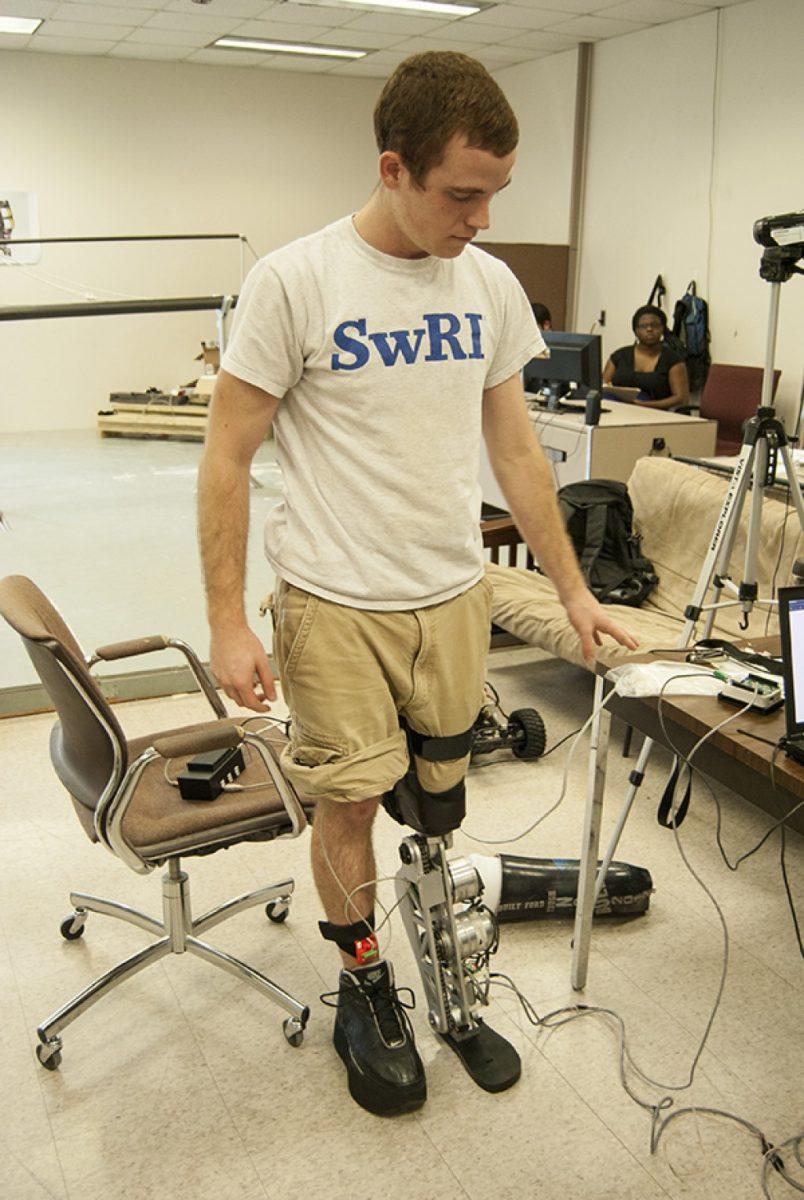For most, the action of walking is done without a second thought, but to Aaron Ames the process represents complex challenges that can be described mathematically, written into software and one day mimicked by robots.
Ames is a mechanical engineering professor at Texas A&M who runs the A&M Bipedal and Experimental Robotics, AMBER, lab. By developing robots that mimic human movements, Ames and the students who work with him aim to gain a deeper understanding of human walking to develop exoskeleton and smart prosthesis that will assist individuals afflicted with amputations and other human body limitations.
The AMBER lab has constructed a number of robots, including the AMPRO, DURUS and AMBER series robots. The lab is devoted to experimental and theoretical research in bipedal robotics, locomotion, non-linear and hybrid systems and prosthetic design. Ames and his students are in the process of developing the third robot in the AMBER series, known as AMBER III.
“We’ve beefed up the AMBER robot series and are focused in trying to get human-like walking,” Ames said. “A lot of the structural elements are similar from AMBER II, so it too has articulated feet and had chain drive but you can tell the scope is a little bit different. AMBER II did some great things but the maximum torque was about 10 newton meters and AMBER III will have over 100.”
AMBER II was the second robot in the series and the first to use a heel-toe movement in order to walk. This differed from AMBER I, which did not have articulated feet and instead possessed long stubs. That small difference made AMBER II more human-like, but because of it, AMBER II was unable to conquer obstacles like binders or folders placed in front of its path.
“AMBER I was much lighter, and that was really the key,” Ames said. “AMBER II struggled with the obstacles and it just ran out of power.”
With AMBER III, Ames’ team hopes to combine the success of conquering obstacles from AMBER I and the development of articulated feet that were featured on AMBER II. The development of the AMBER series hopes to verify formal theories on physical robots, specifically bipedal robots.
Along with his AMBER series, Ames has also developed a smart prosthesis known as AMPRO using the knowledge gained from the lab’s research into robotic walking.
Ames said sensory feedback is taken from an individual’s healthy leg and information is fed to a controller, which then tells the algorithms what to do.
“So if [the individual] moves his leg forward, it’ll phase you through your walk,” Ames said. “The control loop rate is 200 hertz right now, so it’s really fast. On the order of milliseconds, it’s updating based on what [the individual] is doing.”
Prosthetic legs can get expensive, but by developing smart prosthesis Ames and his graduate students believe AMPRO can serve as a useful prosthesis for its technological innovation and projected price.
“We want to be cheap for amputees with our design,” said Huihua Zhao, a mechanical engineering graduate student. “We want to use this device to help people walk more natural.”
Eric Cousineau, a mechanical engineering graduate student, said the research on robots will apply to human development through prosthesis.
Ames is no stranger to robotics research. He received his bachelor’s degrees in mathematics and mechanical engineering from the University of St. Thomas, along with his master’s in mathematics and doctorate in electrical engineering and computer sciences from University of California-Berkeley. Ames has also been recognized for his work, receiving the prestigious NSF CAREER award in 2010 for his research on bipedal robotic walking and its application to prosthetic devices.
“He has such a great math background and he’ll come in and push for new breakthroughs in control theory,” said Eric Ambrose, a mechanical engineering graduate student. “He’s always moving. It seems like every time he’s in [the lab] he has a lot to do but he also is constantly looking at research of what other competitors are doing.”
Ames said the duality of finding simple answer to a complex question is what drives him and he will continue to develop his research in hopes of finding more answers to complex questions.
“I think down the line we shouldn’t need wheelchairs at all,” Ames said. “Instead of getting a wheelchair you would get a frame that you step into and it takes you where you have to go.”
AMBER Lab develops smart prosthesis
September 17, 2014
Photo by Dee Huggan
A member of the AMBER Lab tries on a sophisticated prosthesis that reacts to a wearer’s movements within milliseconds.
0
Donate to The Battalion
$2065
$5000
Contributed
Our Goal
Your donation will support the student journalists of Texas A&M University - College Station. Your contribution will allow us to purchase equipment and cover our annual website hosting costs, in addition to paying freelance staffers for their work, travel costs for coverage and more!
More to Discover










